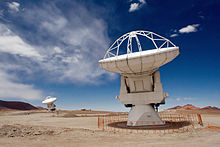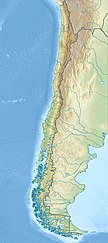Atacama Large Millimeter Array
The Atacama Large Millimeter/sub-millimeter Array (ALMA) is an array of radio telescopes in the Atacama Desert of northern Chile. A high and dry site is very important for millimeter wavelength work. ALMA is being built on the Chajnantor plateau at 5000 metres altitude. It will have 66 12-meter and 7-meter diameter radio telescopes observing at millimeter and sub-millimeter wavelengths. ALMA is expected to help scientists understand how stars were created during the early universe. It will also provide detailed imaging of local star and planet formation.
 | |
| Alternative names | Atacama Large Millimeter and Submillimeter Array |
|---|---|
| Part of | Event Horizon Telescope Llano de Chajnantor Observatory |
| Location(s) | Antofagasta Region, Chile |
| Coordinates | 23°01′09″S 67°45′12″W / 23.0193°S 67.7532°W |
| Organization | National Institutes of Natural Sciences, Japan European Southern Observatory National Science Foundation |
| Altitude | 5,058.7 m (16,597 ft) |
| Telescope style | radio interferometer |
| Website | www |
ALMA is being built by Europe, the United States, Canada, East Asia and the Republic of Chile. Costing more than a billion US dollars,[1] it is the worlds's most expensive ground-based telescope. ALMA began scientific observations in the second half of 2011 and the first images were released to the press on 3 October 2011. The project is should be fully operational by March 2013.
References
change- ↑ Romero, Simon (7 April 2012). "At the End of the Earth, Seeking Clues to the Universe". New York Times. Retrieved 8 April 2012.
